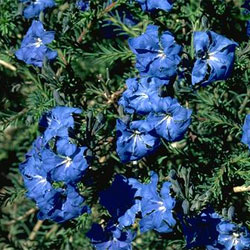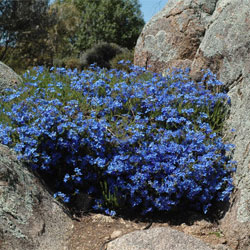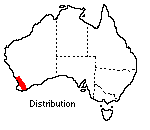Lechenaultia biloba
 |
 |
Blue Leschenaultia
Lechenaultia biloba Lindl. ( as `Leschenaultia' )
The genus Lechenaultia is a group of twenty small woody or semi-woody plants endemic to Australia. Their range of colours and shades of blue, green, yellow, red and white make them highly prized for horticultural work.
 The
correct spelling of the generic name, Lechenaultia, is open to some argument.
It was named after Leschenault
de la Tour, a botanist who visited Australia in 1802-3. However, when Robert
Brown, an early botanist first published the name he spelt it Lechenaultia,
omitting the 's'. The spelling without the 's' is considered valid by Australian
taxonomists.
The
correct spelling of the generic name, Lechenaultia, is open to some argument.
It was named after Leschenault
de la Tour, a botanist who visited Australia in 1802-3. However, when Robert
Brown, an early botanist first published the name he spelt it Lechenaultia,
omitting the 's'. The spelling without the 's' is considered valid by Australian
taxonomists.
All but three of the species are endemic to Western Australia and the most famous of all is the Blue Lechenaultia - L. biloba.
The flowers, which grow to 1.5 cm long by 2-3 cm in diameter, have a tubular corolla, split on one side, and surrounded by five sepals. The corolla has five lobes and when laid flat it resembles an open fan or a hand with spread fingers. In L. biloba the corolla lobes are again divided into two segments, from which the specific name is derived. Flowering time is from late winter through to summer. The leaves are soft, blue-green in colour, 3-9 mm long to 2 mm across, crowded and heathlike.
The plant occurs naturally in gravelly and sandy soils of southern and central Western Australia. In its natural habitat it forms an open spreading plant to 50 cm high.
Various shades of blue are the most common flower colour in L. biloba, but variants exist. One is a pure white form while another, a bicoloured form, has been registered as a cultivar. L. biloba 'White Flash' has a distinct white central portion within the flower and a deep blue outer area.
In cultivation it is essential that the plant is grown in a sandy, well-drained situation. Plants in heavier sites will generally not last a season. The plant is not a long-lived one, three to four years being its most probable life span. A suckering form of the species exists and this has great potential with a probable longer life.
The species is easily propagated by cuttings taken at any time of the year with most success in late spring and summer. Cuttings have reportedly been struck in situ, in rockeries in full sun in front of large rocks. Semi-hardened material 6-10 cm long gives the best results.
Encouraging results with the species have been achieved at the Australian National Botanic Gardens in built-up beds with added limestone chips; however, this is not a prerequisite for their culture. The most important cultivation requirement is a perfectly drained situation, best achieved in rockeries, built-up beds or pots. L. biloba has been successfully cultivated in pots for many years in Europe. Minimal watering is required and the roots will penetrate deeply in a free-draining soil.
Lechenaultia biloba can be allowed to straggle over rocks, or a more compact shape may be obtained by a light pruning after flowering. No injurious pests or diseases have been noted and the species is frost tolerant.
Text by Ron Jackson, ANBG (1981)
Name meaning: Lechenaultia bilobaLechenaultia - after the French botanist Leschenault de la Tour (1773-1826); biloba - referring to the divided corolla lobe. |
![An Australian Government Initiative [logo]](/images/austgovt_brown_90px.gif)

